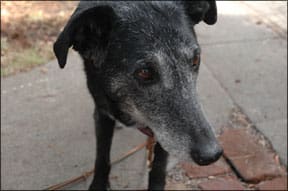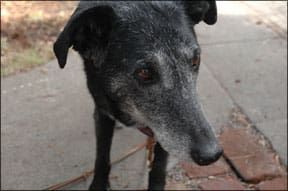[Updated March 28, 2018]
COGNITIVE DECLINE IN SENIOR DOGS: OVERVIEW
1. Help your senior dog at home by following a predictable daily routine.
2. Make gradual, rather than sudden, changes in the household or routine.
3. Use tactile (rugs, runners), and audible (TV, radio) cues to help pets maintain orientation and help with navigation around the house.
Each of us has, at some point, wandered into a room and realized that we’ve forgotten why we’ve gone there. When that happens, chances are we are momentarily perturbed with ourselves, but typically we chalk it up to too much on the brain, remember why we’re there, then move on. Should our dogs wander in the same fashion, it could well be a sign of cognitive dysfunction syndrome (CDS), a condition quite similar to Alzheimer’s in humans. CDS happens when the aging process affects brain pathology, resulting in behavioral changes, including cognitive decline (memory and learning). One of the biggest culprits is the damage done to mitochondria caused by oxidative damage over time. Researchers also believe that a decline in cerebral vascular circulation contributes to the changes we see in our aging dogs.

Testing dogs’ cognitive abilities in a laboratory setting has shown that signs of CDS can be seen as early as seven years of age, yet we, as pet owners, often don’t realize a change in our canine companions until they reach 10 years of age or older. However, dogs trained to a higher level – such as service or guide dogs, agility, and other competition dogs – are those whose cognitive decline might be noticed sooner than that in “just” a pet dog because of a subsequent drop off in the highly trained dog’s performance.
Symptoms of Cognitive Decline in Old Dogs
The gold standard for testing for CDS is in the laboratory. In aged dogs tested in a laboratory setting, researchers observed poor performances on cognitive tasks using a “three component delayed non-matched to position task” (3-DNMP) that tested discrimination learning (ability to select one object over another), reversal learning (after training to select an object, criteria are reversed), and spatial memory (memory of places).
Unfortunately, such laboratory testing is not readily available to us mere mortals. So what should you do? Watch and observe your dog, looking for changes in his or her behavior that might be symptoms of CDS. Traditional “DISHA” categories include:
- Disorientation, including appearing lost or confused in the house or yard; wandering aimlessly; pacing; staring into space or at walls
- Altered Interactions with people or other pets, including not seeking attention or petting or failing to greet family members
- Sleep-wake cycle alterations, including sleeping more in the day, less at night
- House-soiling “accidents”
- Altered activity level
Gary Landsberg, DVM, DACVB, in his paper “Therapeutic Agents for the Treatment of Cognitive Dysfunction Syndrome in Senior Dogs,” published in Progress in Neuro-Psychopharmacology and Biological Psychiatry, notes that we might also see:
- increase in anxiety
- decrease in hygiene/self-grooming
- altered appetite
- decreased responsiveness to stimuli
- deficits in learning and memory
At the same time, it’s important not to jump to conclusions and self-diagnose our dogs if we see any of these signs. These changes can also be due to a variety of medical problems, so it’s important to first rule out environmental factors, physical health, and drug-induced behavior side effects with a visit to your dog’s veterinarian.
I had that very experience with my 12-year-old Bouvier, Axel. When I queried his veterinarian, Susan Wynn, DVM, as to whether his standing very still for periods of time when out in the backyard with me was a sign of CDS, her observation, after further querying me, was that she just wasn’t seeing it. Her hunch was that the behavior was most likely a result of pain from arthritis.

She further explains, “I think CDS is very difficult to differentiate from pain and this is a mistake that is made often. I do see CDS occasionally, but I treat for pain first, and as an acupuncturist, I often find pain that is missed on the conventional exam. If signs of compulsive walking and disorientation remain after two weeks, I’ll usually initiate a trial for cognitive dysfunction.”
What You Can Do for Your Old Dog
If you’re concerned that your canine companion might be showing signs of CDS, don’t panic, cry, or devour a box of bon-bons just yet. The good news is that there are traditional and alternative interventions that can both treat the symptoms and also possibly halt further progression of the condition.
Most exciting of all have been ground-breaking studies examining the positive impact of dietary supplementation and behavioral enrichment that includes social, cognitive enrichment (learning problems), and physical exercise components. Check with your veterinarian to discuss the following alternatives.
Dietary Intervention
A variety of clinical studies have revealed that dietary intervention in the form of an antioxidant-enriched diet improved the learning ability of older dogs, and a resulted in a subsequent decrease in CDS symptoms. Primary supplementation included:
• Vitamin E: Acts to protect cell membranes from oxidative damage
• Vitamin C: Essential in maintaining oxidative protection for the soluble phase of cells as well as preventing Vitamin E from propagating free radical production
• L-Carnitine: Mitochondrial co-factor
• Alpha-lipoic acid: Mitochondrial co-factor
• Other antioxidants from fruits and vegetables (i.e., spinach flakes, tomato pomace, grape pomace, carrot granules, and citrus pulp) that are also rich in flavonoids and carotenoids
Dr. Landsberg notes that it has been suggested that high intakes of fruits and vegetables might decrease the risk for age related cognitive decline through their antioxidant and anti-inflammatory properties, and the addition of omega-3 fatty acids can promote cell membrane health and provide a possible anti-inflammatory effect. Although available in a commercial prescription dog food, the diet can be mimicked by those pet owners who prefer to feed home-prepared, or another type of food by feeding an antioxidant rich diet and supplementing.
Dr. Wynn, who practices alternative and complementary medicine and is the nutritionist at Georgia Veterinary Specialists in Sandy Springs, Georgia, says that antioxidants are the single most important treatment for her clients diagnosed with CDS, adding that “any older dog with clinical signs” is a good candidate. In addition to antioxidants, she uses acetyl-l-carnitine and alpha-lipoic acid. She also recommends herbs, preferring to treat with lemon balm, gingko, bacopa, and gotu cola. In her experience, she expects to see results “usually within two weeks.”
Dr. Wynn agrees, too, that for those people so inclined, “Use the diet you want, plus antioxidants and alpha-lipoic acid and acetyl-l-carnitine supplements.”
Behavioral Enrichment
Just as exciting is the research reported in Neurobiology of Learning and Memory, “Enhanced Spatial Ability in Aged Dogs Following Dietary and Behavioural Enrichment” (P.M.D. Nippak, J. Mendelson, B. Muggenburg, N.W. Milgram). This study tested aged dogs on a 3-DNMP test, and followed the results of dietary intervention and behavioral enrichment on the cognitive abilities of aged (and control) dogs in the trial for three years. As has been found in previous studies, dietary intervention in this study ” . . . led to rapid improvements in learning and within two weeks, significant improvements in spatial attention.” Over time, learning ability improved as well, while untreated dogs showed progressive decline.
In their test of the effect of behavioral enrichment on cognitive abilities, researchers reported that the dogs showed similar improvements to those receiving dietary intervention. Behavioral enrichment included increased exercise, environmental enrichment (kennel mate, toys alternated weekly), and a program of cognitive enrichment. Why? We can only guess, based on data from human studies that tell us:
• Physical activity is associated with improved cognitive function and lower risks of cognitive impairment and dementia.
• Enriched environments improve learning ability and ” can be sufficiently robust to reduce or eliminate age-dependent cognitive decline, particularly if intervention is instituted early in development.”
• Cognitive experience is linked to the absence of cognitive dysfunction, with an inverse relationship between educational level and rate of cognitive decline later in life; studies also show that patients with dementia demonstrated an improvement in cognitive performance following the implementation of special cognitive training protocols.”
Jonna Kanable, Certified Canine Rehab Practitioner (CCRP) with Atlanta Animal Rehab and Fitness in Roswell, Georgia, is a firm proponent of the exercise piece of the puzzle. “If you look at it from the common sense standpoint, if you increase blood flow to a particular organ, you’ll see more nerves firing and more synaptic involvement, and you should definitely increase cognitive ability at that point, too.

“In my own experience, I’ve had a lot of elderly canine clients for exercise (underwater treadmill) who were arthritic but also showed symptoms of CDS. They were prescribed exercise to help out with the arthritis, but we also saw their cognitive ability improve.”
Kanable also reported seeing dogs with “more peppiness, not that listless stare; they’re looking around more, and definitely seem to be more energetic afterward.” The more weekly sessions the dogs attended, the longer they “held” their treatments and demonstrated more voluntary movement at home instead of just lying or standing in one spot. Plus, she adds, “All the owners, every single one of them, said with exercise during the day they saw improvements (a decrease) in their dogs’ pacing behavior (a classic CDS symptom) at night.” Kanable believes daily exercise is the key. Even if it’s short periods of exercise – 10 to 15 minutes at a time, two to three times daily, for an elderly pet, depending on their level of conditioning – owners should expect to see better quality of sleep for their pets and better cognitive ability.
In addition to exercise, enriching your dog’s environment could include short outings to meet people and take in new sights and sounds; visits with other dog-friendly pets; mini-daily training sessions; a low key training class; and a weekly rotation of toys. Whole Dog Journal‘s Training Editor, Pat Miller, lists the following activities as a few of her favorites to keep your dog’s brain engaged:
• Shaping games, including “101 Things to Do With a Prop,” or directed shaping of a specific task; great because these can be played no matter how much a dog may be physically limited.
• Playing with interactive puzzle games.
• Targeting games such as touch an object, go outs, and object discrimination.
• Playing “find it!” (hide a toy or treat).
• Playing with interactive stuffed toys with “parts” the dog pulls out or apart.
Diet + Behavioral Enrichment = Best Formula
All these things are helpful for dogs with CDS, but what researchers discovered was that the combination treatment group – the one that received both dietary and behavioral interventions – consistently demonstrated greater benefit than groups receiving a sole treatment. Prior reports indicated that the “3-DNMP” task was too difficult for aged animals, yet this study showed aged dogs making fewer errors and responding more slowly (actually a good sign!) on these complex tasks.
While Dr. Wynn likes to start dogs on antioxidants at roughly nine years of age as “prevention,” she, too, is a big believer in the power of behavioral enrichment in combination with dietary intervention.
“I think that, as in humans, if you don’t use it, you lose it,” says Dr. Wynn. “Some older dogs are left at home with nothing to do but dwell on their anxieties – the gradual loss of hearing and sight, increasing stiffness and pain. I really think they dwell on these changes unless they are given other things to do and to think about, and are provided with adequate pain control. So we should manage their pain very aggressively with acupuncture, massage, herbs, chiropractic, physical therapy, and drugs, and provide them with small projects, or if possible, keep them in training. Training and exercise should never stop.”
Nutraceuticals
A variety of nutraceuticals intended to boost brain power are available. Studies that indicate that Juvenon®, available for dogs as “Vigorate,” is effective for canine CDS. Other available nutraceuticals include Memoractiv™, Geriactive®, Proneurozone™, and Senior Moment®. At this time, the efficacy of these products has not been proven through clinical trials or cognitive studies, although some users report seeing improvements in their dogs.
Pharmaceuticals
Currently, the only veterinary pharmaceutical approved by the FDA for treatment of CDS is Anipryl® (selegiline hydrochloride, L-deprenyl hydrochloride). This drug has also been used in the treatment of Alzheimer’s in humans.
Like any drug, Anipryl can cause adverse reactions and side effects, and should not be used in combination with drugs that include, but not limited to, phenylpropanolamine, ephedrine, other tricyclic antidepressants (Clomicalm), amitraz (Mitaban dips or Preventic collars), fluoxetine, mirtazapine ( a tetracyclic antidepressant used as an antiemetic and appetite stimulant, often in cancer patients), and tramadol. A thorough review of current medications and an in-depth discussion with your veterinarian are in order should you decide to take this route.
Other pharmaceuticals being studied, according to Dr. Landsberg, are those that enhance cerebral vascular circulation and drugs that increase alertness and regulate sleep-wake cycles. Antidepressants might also help (i.e., clomipramine), as might anti-inflammatory drugs and hormone replacement therapy, although clinical trials have yet to be run specifically for treatment of CDS with these interventions.
Prepare While Your Dog is Sharp!
Think your friend is not quite ready for the senior center? Well then, now is the perfect time to get serious about updating his diet and engaging him in an active lifestyle. Human epidemiologic studies suggest that maintaining an active lifestyle can protect against pathological aging. Participation in cognitively stimulating or physical activities that lead to improved function reduce the risk of developing Alzheimer’s. Reduced intellectual or physical activity in middle age has been shown to lead to a higher risk of Alzheimer’s later in life.
Since some treatments might actually slow the progression of disease rather than simply treat symptoms, it’s best to start treatment of senior dogs prior to onset of clinical signs. At the end of the day, it’s a win-win situation, with both of you benefitting from a change in lifestyle that incorporates an antioxidant-rich diet, exercise, and cognitive stimulation.
Lisa Rodier lives in Alpharetta, Georgia, with her husband and two Bouviers.






